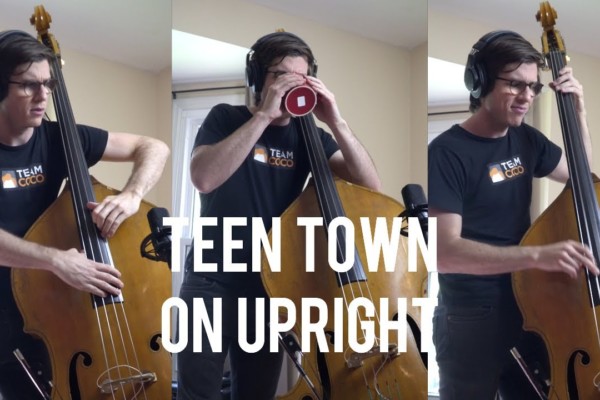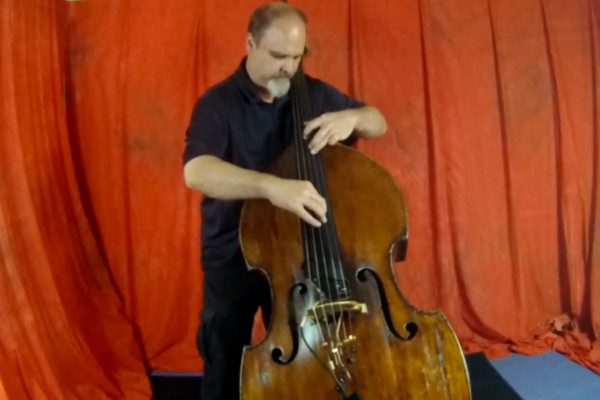Common Upright Bass Tunings (Part 1 of 2)
One of the beautiful things about upright bassists is their unwillingness to conform. When it comes to tuning, we often refuse to conform not only to the practices of other instruments in our family, but also to each other! Although 3 string basses are largely a thing of the past, there are still uprights with 4 strings, with and without an extended E (aka “C” extension allowing the string to go to C or even B), and 5 strings. All of these instruments have variations in tuning.
Orchestral Tuning
The most common occurrence found out there in Bassland is a 4 stringed instrument, tuned in fourths: E A D G. This mimics the standard Electric Bass tuning and is often referred to as Orchestral Tuning:

This is the typical tuning used by orchestral players, which is where the term comes from. If someone says “Standard” tuning, this is what they mean. Most bass methods are designed with this tuning in mind and when classical composers are writing for the bass, their orchestration books tell them that this is how the bass is tuned. It is also the most common tuning used by players in jazz, rock, bluegrass, etc.
When you see a set of upright strings listed as “orchestral gauge” the manufacturer is telling you that the strings are designed (in terms of best response, tension etc.) to be tuned E A D G. They feel the need to do this because of…
Solo Tuning
The second most popular tuning is called Solo Tuning. This is also a fourths based tuning, but is one step higher than Orchestral Tuning. The result is F# B E A:

?
This tuning is most commonly found when the bass is playing a more “up front,” solo role in classical music. For example, when someone is playing a Bass Concerto. Hence the term Solo Tuning.
Classical bass soloists in the 1800’s, such as Giovanni Bottesini, began experimenting with string materials and tunings in an effort to give their instruments more volume, projection and brilliance. They were trying to give the bass a more soloistic timbre. The tuning above took hold and is still used by contemporary players and composers. Although some players fly the anti-solo tuning flag, a vast repertory of works exists for bass with this tuning and contemporary composers still write for it.
In fact, Solo Tuning is common enough that most string makers produce both Solo Gauge sets for each of their string lines. If the strings are listed as Solo Tuning, or Solo Gauge, they are designed for the tuning listed above.
Solo tuning strings tend to be thinner than orchestral strings, making them somewhat easier on the left hand as well. It is not uncommon for Upright Slap players to buy Solo Tuning Strings, and tune them E A D G. This puts the strings at a lower tension, which makes it easier for both the left hand and the slapping hand.
Tuning in Fifths
A third tuning, which has been in existence since the origins of the upright bass, is tuning in 5ths, one octave below the sound of a cello, C G D A:

Some notable players who advocate this tuning are: Joel Quarrington (soloist and principal bass of the Toronto Symphony) and the late jazz great Red Mitchell. Supporters of this tuning dismiss concerns of increased left hand workload and cite the increased resonance of the instrument as a relevant factor, among other things.
Not all string manufacturers produce a set of strings for 5ths tuning, but some do. Those who produce them denote them as either “Red Mitchell” or simply “fifths tuning.” If you don’t like the brands, or production lines, of strings available as a fifths tuning set, you can create your own out of other orchestral and solo tuning stings:
- Take a low B string (originally designed to be lowest string on a 5 string bass) and tune it up 1/2 step higher to C
- Take an F# solo string and tune it up 1/2 step higher to G
- Use an orchestral tuning D string and a solo tuning A string to complete the set.
- You are now in fifths tuning!
Combination Tuning
Another tuning that has gained popularity in recent years is the combination fifths/fourths tuning of E B E A:
?

Ludwig Streicher went on record promoting this tuning many years ago and Stuart Sankey required it for his edition Schubert’s “Arpeggione” Sonata. It really began to gain recognition, however, in the 1990’s as Edgar Meyer’s tuning of choice (low C Extension not withstanding).
Next time: C extensions, 5 String Tunings and tuning practice suggestions
Dr. Donovan Stokes is on the faculty of Shenandoah University-Conservatory. Visit him online at www.donovanstokes.com and check out the Bass Coalition at www.basscoalition.com.




I personally keep all my basses including my upright in drop D tuning
Dadg works well for playing with instruments in flats, the extra Eb and D seem to give my upright better resonance.
Brian Gibson from Lightning Bolt uses fifths tuning on his bass guitar but uses tenor banjo strings since it’s in the same tuning.
[…] instrument. (Botsford is principal bassist for the Oregon Symphony.) He helped himself by adopting “solo tuning,” giving his instrument a more cello-like tone, but there was plenty of passion flowing down that […]